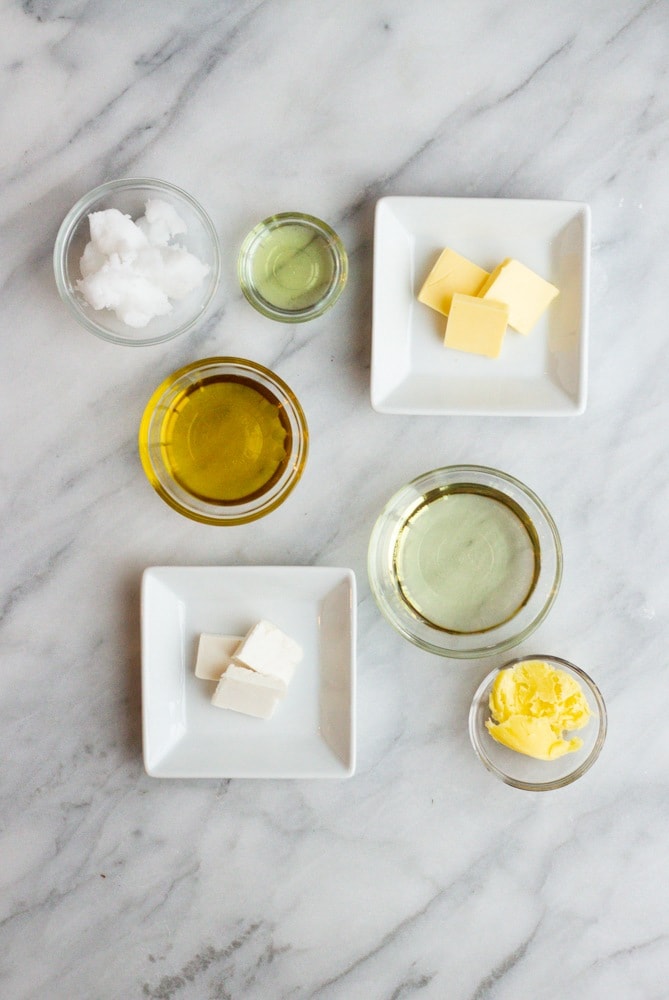A collection of different types of fat to use as you cook! Learn which fats to use, how to use them, and what they offer.
Fat = Flavor (And More!)
Fat unfairly has a bad reputation. There’s a negative connotation that comes with the idea of adding any form of “fat” to our food…which is simply preposterous.
The body uses fat as fuel, making it necessary and beneficial to your health. It’s important to note, of course, that some fats can be harmful to your health, and should be limited if not avoided altogether. The key here is balance! I’m no dietician, and while fat broadly is an important part of your diet, I definitely recommend chatting with your doctor about the right approach for you personally.
That said, the below fats are those that I use in my own cooking, and I’ll share the ways I love to use them!

Coconut Oil
The uses of coconut oil are absolutely endless. I always have virgin coconut oil in my pantry. It adds a light flavor to stir-frys, baked goods, and fresh-popped popcorn. Since it solidifies at room temperature, it makes an excellent base for a glaze for sweet treats: just add cocoa powder!
I also keep a bottle of fractionated coconut oil in my bathroom to use as skin and hair hydration. It has a very delicate scent that isn’t “coconutty” at all, making it a great carrier oil as well.
Grapeseed Oil
I love having grapeseed oil on hand for vinaigrettes and dressings. Grapeseed oil tends to have a more neutral taste, making it an excellent option for homemade mayonnaise. At times, olive oil can be overpowering in such simple sauces, so having this light, omega-6 rich oil on hand is a great option.
Butter
Its distinct taste and richness are universally known and loved, although not all butter is created equal. Salted, unsalted, grass-fed, European, cultured…there are plenty of options to choose from, with each category delivering varying degrees of quality!
Personally, I’ll adjust the type of butter I buy depending on how I’m going to use it. If I’m baking, I’ll typically opt for unsalted: in general, I always select unsalted. The reason being that you know the amount of salt going into your recipes, having greater control over the taste of what you’re making. If I’m using butter for bread, for example, I’ll typically opt for grass-fed as I believe it tastes better.
Olive Oil
Ah, the world of olive oil. It’s an illustrious industry that has produced countless varieties, blends, flavors, and brands. Whether you’re using it to sauté, fry, bake, drizzle, or emulsify, olive oil deserves a prioritized spot in your pantry. Try out both regular olive oil and extra virgin options to determine which you prefer (extra virgin tends to be lighter in color and taste). I love experimenting with flavored olive oils as well, finding amazing options at local olive oil specialty shops.
Vegetable and Canola Oil
Vegetable and canola oils are are excellent options for frying. They’re universally known and inexpensive, both having a light and neutral taste. Canola oil is low in saturated fat and high in monosaturated fat, giving it a reputation as a healthy oil. As with all fats, however, best to use these two oils in moderation.
Vegan Butter
Vegan products have come a long way, butter being one that I’ve surprisingly fallen in love with! I have nothing against vegan products, but I haven’t necessarily had a need for them…until I tried vegan butter for the first time. It spreads like a dream and is particularly delicious slathered on a slice of warm, freshly baked bread. Use it in place of regular butter, any way you like!
Ghee
A staple in Indian cooking, ghee is butter that has been heated and strained, thus removing lactose and offering deeper flavor. It’s an excellent option to sauté aromatics for a warm curry, fry eggs, or drizzle over vegetables before serving.
How To Store
Oils
Oil should be kept in a cool, dry location in your pantry. Some oils have a tendency to go rancid when kept at warmer temperatures or exposed to oxygen. If you purchase an oil you don’t think you’ll use very often, best to keep it in a spot that’s visible (i.e. the front of your pantry!).
It’s always a good idea to keep up with the freshness of the items you store in your pantry, and oil should be no exception. I like going through my pantry on a seasonal basis to check dates, get inspired, and use up what I have (or toss if it’s no longer good!).
Butters
I’ve always been one to store my butter in the refrigerator, as I don’t use it enough to warrant a spot on my countertop. If you use butter more regularly, perhaps enjoying buttered toast each morning, I recommend keeping just the amount you know you’ll need out for the coming week. Any amount of time beyond that could be questionable as it relates to food safety.
In seasons when I know I’ll be using a lot of butter (such as the holidays!), I’ll typically buy in bulk and store some in the freezer. Though this is a space-constrained related issue, it’s nice to know that I should always have butter on hand – even if it’s frozen!
Find this article about the different types of fat to use in your cooking helpful?
Check out my “So Happy In The Kitchen” page, where I share helpful roundups of products, ingredient and cooking method education, and recipe tips and tricks! You can also shop all of my favorites here.


